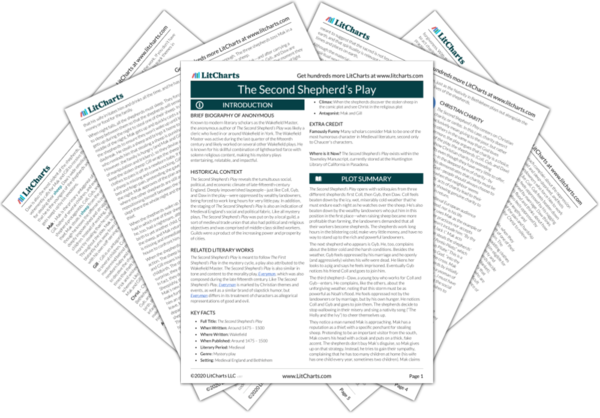The Second Shepherd’s Play is a “mystery play,” which is a Medieval play meant to simultaneously entertain the audience and teach them biblical lessons. Echoing the mystery play’s twofold purpose, the songs in The Second Shepherd’s Play are meant to be both engaging and didactic. They pull the audience in with their beauty or humor, while simultaneously providing serious religious teaching on the importance of the nativity. Throughout the play, songs appear in moments associated with transformation; they shift the tone between scenes, and they transform the shepherds’ moods, and later, their lives, when the Angel appears to them and sings of Christ’s birth. This association of song with transformation reveals the purpose of the songs: to transform the audience’s lives by luring them into spiritual truth through entertainment, showing that even lighthearted song can be a vehicle for serious religious messages.
At the beginning of the play, song is a tool to lighten the mood and make the play entertaining. “The Holly and the Ivy” marks the play’s initial shift in tone from serious and socially critical (as seen in the shepherds’ soliloquies) to lighthearted and farcical, as seen with Mak’s comical introduction. Throughout the play, song adds an entertaining texture, infusing the action with both beauty and comedy. This is most notable when Mak sings an out-of-tune lullaby to the “baby,” which is actually the stolen sheep in swaddling clothes. When the shepherds—Coll, Gyb, and Daw—enter Mak’s home, Mak exclaims that the shepherds must speak more quietly as to not wake the baby, which points to the farcical nature of the first half of the play. The entertaining nature of the songs keeps the audience engaged throughout the play and breaks up the heavy, religious content into more digestible pieces.
However, song is shown to have a much more serious purpose, as well. This is first hinted through song’s power to lift the shepherds’ moods. After reciting their soliloquies and wallowing in their sadness, the shepherds sing to cheer themselves up. Singing uplifts them, giving them something fun to do together that will band them together and momentarily take their mind off of their struggles. It’s also significant that the song they sing—“The Holly and the Ivy”—is a nativity song. The uplifting message of the nativity combines with the cheering element of song to transform the shepherds’ moods. This combination of religion and entertainment suggests that, although faith is solemn and significant, it is also full of beauty and hope.
Just as song transforms the shepherds’ moods at the beginning of the play, it transforms their lives at the end. When the Angel sings of Jesus’ birth to the shepherds, they realize that they have been chosen to journey to Bethlehem and meet the Christ child. This leads to their salvation, which is the ultimate transformation of their lives, as it relieves their suffering and grants them eternal life.
While the Angel’s song signals profound spiritual transformation, its structural role in the play—as a hinge between the first comic and second spiritual half, and as the first indication of the parallel plotlines of those halves—underscores the transformative power of song. After the Angel who sings of Jesus’ birth disappears, the shepherds are in awe of the Angel’s musical skill. Jokingly, Coll asserts that he can sing as well as the Angel—a brief moment of comedy that marks the pivot between the comedic first part of the play and the solemn, religious end of the play. In addition, the Angel’s song reveals the parallelism in the play’s two plotlines. The shepherds, who sing a nativity song at the beginning of the play, go on to forgive Mak and transform his life by sparing him from the death penalty. The Angel, who also sings a nativity song, transforms the shepherds’ lives by leading them to their salvation in Bethlehem. The play’s emphasis—thematically and structurally—of the transformative power of song comes to a powerful conclusion when the play ends with the shepherds singing about the nativity so that the audience will hear the story of Christ. This suggests that the play’s songs are meant to be a way of transforming the audience’s lives by informing them of Christ’s power to redeem them. By closing with the shepherds’ intention to spread the news of the nativity, the play encourages the audience to do the same, which points to the power of song to transform lives both inside and outside the play’s action.
Song as a Means for Transformation ThemeTracker

Song as a Means for Transformation Quotes in The Second Shepherd’s Play
Ere we go now, I would someone gave us a song.
So I thought, as I stood, to beguile us along.
Rise, herdsmen, rise, for Christ is born / To rend that fiend that Adam had lorn / The Saviour of all, this night is he born. / His behests / To Bethlehem go see / Where lies this baby / In a crib full poorly / Betwixt two beasts.
Hie we thither right merry / If we be wet and weary / Still, we’ll find the child and lady, / We cannot lose.











